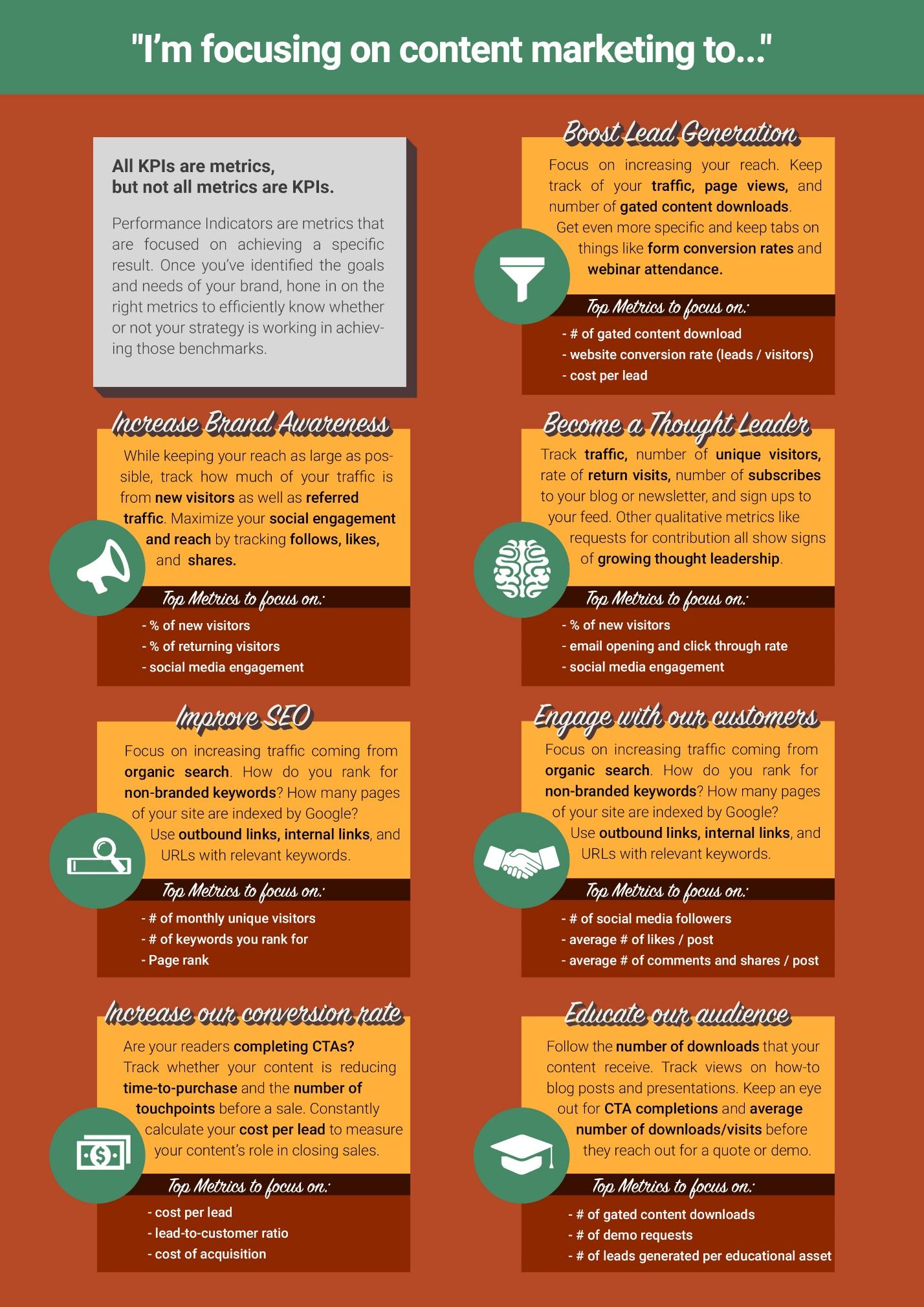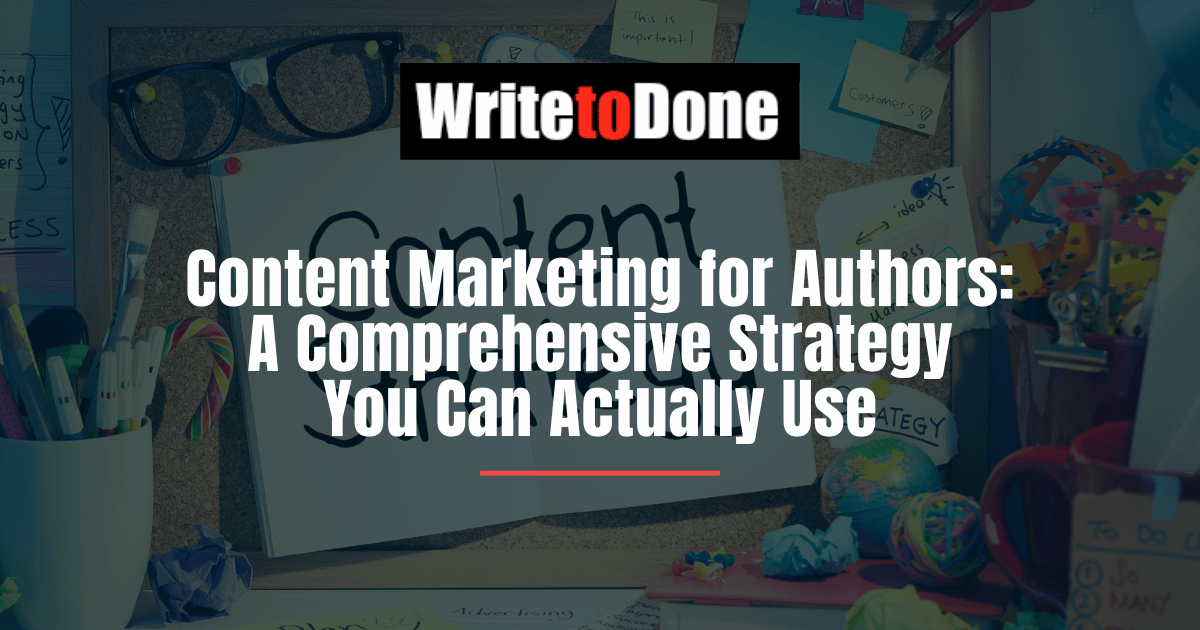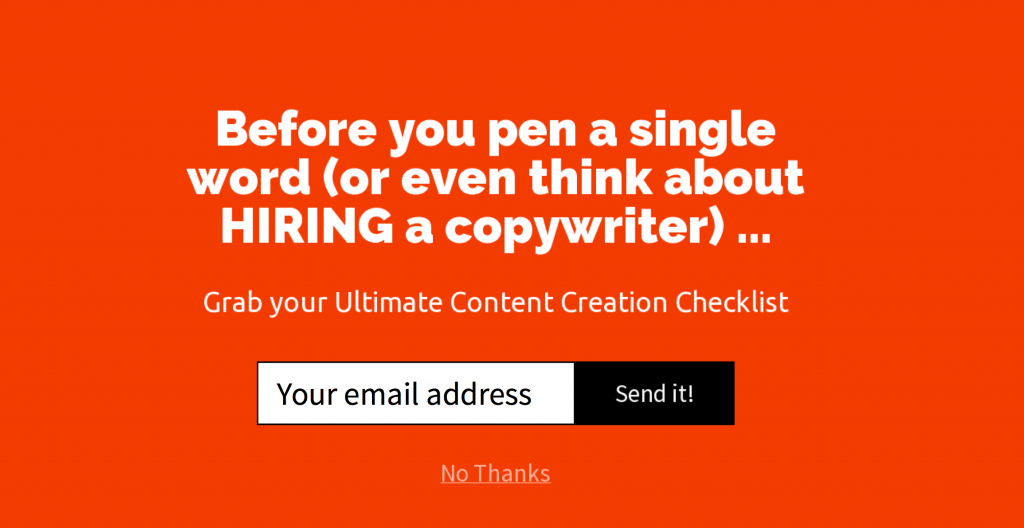Let’s start with the bad news: the vast majority of online content never gets noticed. Period, end of story, thanks for playing… goodbye and goodnight.
Of course, if you’ve spent any time in the overcrowded world of online writing, you’re already acquainted with the pain of obscurity.
Few experiences are more disheartening than laboring over a masterpiece – outlining, crafting, writing, editing, rewriting and rewriting and rewriting – only to hit publish and be greeted by the universal sound of digital crickets.
However, don’t feel too bad. Turns out, you’re not alone in your struggle.
According to a recent Moz and Buzzsumo study of over one million posts, more than 75% of all online articles never earn a single external link and over 50% never get more than two Facebook interactions: shares, likes, comments or otherwise.
So should you just give up on your dreams as an author?
Absolutely not.
Instead of throwing in the towel and resigning yourself to the internet graveyard, the answer is to get strategic by befriending a term that has exploded online over the last five years: content marketing.

To do this, you need one thing – a plan: a comprehensive, step-by-step guide to content marketing for authors, even if you’re not a “marketer.”
That’s exactly what this post contains. However, before we dig into the five steps, let’s start with exactly what content marketing is.
What is content marketing for authors?
At its root, content marketing boils down to sharing real solutions to real problems for real people – and doing it for free.
In a word, it’s about creating value. Tony Robbins captured this perfectly in his recent juggernaut MONEY: Master the Game:
Money is nothing more than a reflection of your creativity, your capacity to focus, and your ability to add value and receive back.
If you can find a way to create value — that is, add value for a massive number of people — you will have an opportunity to have a massive amount of economic abundance in your life.
Even if you don’t consider yourself a marketer, the ultimate objective of content marketing is to forge a mutually beneficial relationship with your target audience; a relationship that, over time, can morph into money.
Naturally, content marketing for authors can take many forms: from blogging and email campaigns to ebooks and online courses to webinars and podcasts. This can feel overwhelming. Thankfully, developing a content marketing strategy can be broken down into five steps:
- Your Goal
- Your Audience
- Your Bribe
- Your Content
- Your Calendar
1. Your Content Marketing Goal
It’s staggering how often content marketing strategies begin with nothing more than good intentions: “I need to do content marketing. But please – no follow-up questions.”
Sadly, good intentions by themselves do not lead to tangible results.
As with other things in life, a usable content strategy has to start with a clear picture of what you want to accomplish. Linda Formichelli offers two imperatives on this front:
- Your goals need to be something you can control.
- Your goals need to inspire you.
Getting clear about your goals demands writing them down in black and write.
It also demands adding a third, quantitative ingredient on top of Linda’s qualitative essentials:
Your content marketing goals need to be measurable.
Be as specific as possible. Instead of making your goal something ethereal like, “Increase visits and share,” or – at the risk of insulting Linda – “do more teaching and mentoring,” link it to real numbers:
“Launch a new online writing course within six months that includes at least 15 paying students.”
“Increase the number of my newsletter subscribers by 500 within three months.”
“Attract and close two new freelance clients at $2,000 in the next five weeks.”
“Publish my first novel within a year and build a Facebook fan page with at least 2,000 people to release it to.”
The more granular your goal, the more effective your performance. The rest of your strategy – what you’ll actually do – has to be in service of that goal.
To get clear about what you want to accomplish, read through Pressly’s uber practical infographic, “I’m focusing on content marketing to …” Notice that each category opens with an overarching qualitative goal – “Increase Brand Awareness” – and closes with measurable quantitative goals to match – “% of new visitors, % of returning visitors, social media engagement.”

2. Your Content Marketing Audience
Step one was about you.
Step two – despite the misleading word “Your” in the subhead – is all about them: your audience, your market, your visitors, your tribe.
Knowing the role “they” will play in your content strategy sounds like a no-brainer. After all, if content marketing is sharing real solutions to real problems for real people and doing it for free, then everything hinges on how well you know those real people.
Sadly, this is precisely where a lot of content strategies go off the rails.
Why?
Because humans are incredibly self-centered. We naturally gravitate to whatever we think is important, meaningful, insightful and valuable. As a result, we end up writing for ourselves instead of for the people we’re trying to serve. And our audience can see right through that:

I’m not saying you should be a sell-out and pander to the lowest common denominator. Far from it. Knowing your audience gives profound weight and substance to your writing and content strategy alike.
When Glen Long defines the three “elusive qualities of good writing that can’t be taught,” his very first quality is …
Empathy – the ability to put yourself in the mind of your reader or your characters. Empathy allows the blogger or freelance writer to connect powerfully with their chosen audience. It helps the novelist create believable characters who are nothing like their creator.
Likewise, Leanne Regalla from Make Creativity Pay calls empathy “the master key to all doors leading to blogging greatness”:
Simply stated, the better you understand your audience, the more enthusiastically they’ll respond to everything you do.
Without empathy, your blog doesn’t have a chance in hell of succeeding.
And just in case you prefer your proof texts with a more artistic bend, consider John Steinbeck’s advice:
Your audience is one single reader.
I have found that sometimes it helps to pick out one person – a real person you know, or an imagined person – and write to that one.
All these brilliant writers are saying the same thing: “they” matter, and they matter a lot.
While bigger companies can sometimes get away with broadly defining their audiences, solopreneurs are better off targeting a specific niche for their initial content.
In this sense, singularity is key: “Who is your one ideal target audience?”
In my own Content Creation Checklist, I force new clients to answers no less than 26 questions when defining their audience.
First, nail the big-picture questions: “Are you B2B or B2C? What size businesses do you serve? Which industry?”
Second, address the demographic issues: “What is your ideal audience member’s average gender, age, income level, education, occupation, family-size, ethnicity, etc.?”
Third, get emotional: “What does your audience hate – about their life, their job, or about your type of product or service? What does your audience love – about their life, their job, or about your type of product or service?”
To really drive these emotional questions home, I often ask clients to describe them in theological terms: “What hell does your audience want to be saved from? What heaven do they want to be delivered unto?”
Lastly, get shallow: “What is your audience embarrassed or insecure about? Where (especially online) does your audience go to for answers, help, and just to hang out?”
Whatever approach or tool you adopt – whether you use my guide or something like Demian Farnworth’s Empathy Maps: A Complete Guide to Crawling Inside Your Customer’s Head (see below) – do not proceed to the next step until you complete this one.

3. Your Content Marketing Bribe
Alright, enough touchy-feely talk about empathy and your audience.
It’s time to take action.
However, this doesn’t mean creating content – at least, not yet. Nor does it mean going for the sale.
Instead you need a halfway house between the two: a strategic, action-oriented something that connects the two with momentum. And no, simply setting up a contact page won’t do.
Enter your bribe.
Your bribe is a free offer designed to transform your audience from Step 2 into genuine leads – most notably, email subscribers or social media followers – that will ultimately complete your goal from Step 1.
That’s a mouthful of a sentence, but it’s actually pretty simple.
For example, if you arrived at this article in any way other than Mary’s email list, the first thing you saw was a bribe:

Jon Morrow’s SmartBlogger takes the same approach:

Likewise Carol Tice’s Make a Living Writing:

Jump over to my site – iconiContent – and yep, I’ve got one too:
If you visit Joanna Penn’s The Creative Penn, you’ll find not one, but two bribes. The first centered on the page itself:

And the second as a pop-up when you scroll about halfway down the page:

What if you’re not a writing coach but an actual author?
Consider New York Times best-selling author Brad Thor’s bribe seeded throughout his website to “Go Beyond the Books with Brad”:

Even better is Lisa Unger’s bribe to get an “Insider’s Guide” to her books as well as “a chance to win books every month, automatically!”

All these approaches – from both writing coaches and authors themselves – have one thing in common: they center their call-to-action around a single objective: “Here’s something valuable. You can have it for free. Just sign up.”
While it may seem like creating your own bribe would be a laborious and time-consuming process, don’t get fooled. Jenna Dalton’s The Quick and Dirty Guide to Creating Your “Bribe to Subscribe” in Record Time offers a fantastic overview of how to create your own bribe painlessly and easily.
Jenna points out that going “too broad” and “too big” are the two most common mistakes writers make when building their bribe. To solve these mistakes, Jenna outlines a better, more “narrow” way forward:
Instead of trying to tackle all of your audience’s problems, you’ll narrow them down to just one specific problem.
And to make it super easy, we’ll only consider problems that fit the following template:
I want [goal], but [obstacle].
For instance:
I want to eat healthier, but it seems too complicated.
I want to start a blog, but I’m not sure which topic to choose.
I want to get more freelance clients, but I don’t know where to start.
In a similar less-is-more vein, one of Mary’s own bribes is a guide on creating an “IRRESISTIBLE Lead Magnet in Less than 5 Hours.”

At the risk of getting meta, Mary offers readers a bribe on creating bribes. Inside, she echoes the advice of Jenna, but instead of calling them “bribe to subscribe” offers, Mary calls them “opt-in gifts”:
Some of these Opt-in gifts take months to produce. For example, if you write and publish an ebook or create a course.
However, big items (like ebooks, courses, or webinars) aren’t necessarily more attractive than opt-in gifts that can be consumed more quickly.
In fact, the most effective opt-in gifts are resource lists and checklists.
The good news is that you can create such opt-in gifts in five hours or less!
The ultimate output of both Jenna and Mary’s processes should be nothing more than a one-page checklist laser-focused on the single, most pressing, most hell-inducing problem your audience wants to solve. You can always go bigger later – as we’ll see when we dig into the template after this strategic overview – but you don’t need to.
After you’ve created your bribe, next determine how you’re going to offer it.
Dotting your website with multiple offer forms increases the chances of growing your email list, recruiting fans, and (in the end) improving sales.
Let’s look at the two major types of offers:
1. Pop-Up Bribes
Pop-ups suck. That’s the consensus, anyway.
But they don’t have to.
When cleverly timed and deliberately placed, pop-ups are actually one of the most effective techniques to increase your bribe’s conversion rate.
Most of the above screenshots come in the form of welcome pop-ups. These are pop-ups that automatically appear the first time someone visits your site.
Alternatively, you can use pop-ups after a visitor has spent some time getting familiar with you and your site. This can be done through scroll pop-ups that appears once someone has read a pre-determined percentage of your page (like Joanna Penn did in her bribe’s second appearance) or through exit pop-ups that appear when your audience moves their mouse to close the browser or leave.
The best way to make your pop-ups less annoying is to make them personable, which is great news if you’re a writer. A couple of my favorite examples come from KlientBoost, who nails being personable in their exit pop-ups:


2. End-of-Post Bribes
End-of-post forms are minimally intrusive and appear at the bottom of each article or page. When people are interested enough to scan or read through your entire article, they will be far more engaged and likely to give up their contact information than with a pop-up.
End-of-post forms also give you an opportunity to adapt the language of your offer to the content. And contextually relevant bribes always convert better.
I use this approach whenever I’m developing serial (or sequential) content on my website, like I did with a string of posts based on Eugene Schwartz’s Breakthrough Advertising. At the end of the first article, I included a summary of the upcoming 3 Unbreakable Laws of Breakthrough Copywriting and this simple opt-in:

4. Your Content Marketing Content
Finally, we’ve arrived at the question you knew was coming. “What content should I create for my content marketing strategy?”
This is an incredibly daunting decision.
Thankfully, you don’t have to go it alone. In fact, you shouldn’t.
Once you’ve defined your goal, your audience, and your bribe, let them determine the kind of content you invest in.
Put simply: effective content marketing strategies aren’t invented – they’re discovered.
Here’s what I mean. Whenever I’m developing content – whether for myself or for a client – I start by using two tools to get inside the mind of my audience and find out what they want.
Number one: Buzzsumo.
Buzzsumo lets you identify – either by site or by keywords – the most popular social media content your audience is already in love with. A few months ago, I plugged into a site I know my target audience frequents – Forbes.com. To my surprise, I discovered that their most popular post over the last twelve months was “5 Minutes Early is On Time; On Time is Late; Late is Unacceptable”:

Over 400,000 shares about punctuality.
Armed with that knowledge I created what became my first article for Lifehacker.com, a publisher I’d previously tried to crack with four articles, all of which were rejected.

Where previously I’d started with myself – what I thought was compelling and interesting – this time I started with my audience. And the difference in results was like night and day.
Number two: Google Trends.
What Buzzsumo is to social media, Google Trends is to search engines. Simply enter a topic, location or category and Google Trends will tell you exactly what top search terms the people you’re trying to reach are already looking for.
Two years ago, before I knew anyone in the online writing world, I used Google Trends and discovered that Mindy Kaling from Fox’s The Mindy Project was on fire.

At the time, I myself didn’t know much about Mindy, but I intentionally capitalized on her search popularity and – with a little bit of additional research – put together The Mindy Kaling Guide to Entrepreneurial Domination, which opened the door for my first article on Entrepreneur.com as well as an ongoing contributor spot there.

In addition to these tools, you can also lean on proven content templates to determine what to create. Here’s a quick rundown of my favorite go-to types:
- Delight with Data:
Evidence-based posts are “viral gold” because they establish your authority, credibility and individuality. Whether you are sharing the results of a personal test or the outcomes of an online survey, providing original data, or displaying existing data in a novel format, this one is always a crowd-pleaser. - Swim Against the Tide:
Have a contrary viewpoint about a popular topic? Speak out. Offering your unique spin on a trendy (or even stale) topic is one of the surest ways to get your voice heard. What you stand against – as long as you’re genuine – is often more powerful than what you stand for. - Look into Your Crystal Ball:
Today’s fad is tomorrow’s flop. Things change at supersonic speed in every industry. If you possess the talent for visualizing the future, flaunt it and hook your audience. Even if you end up being wrong, writing a follow-up is a great way to show your humanity and connect even more deeply. - Mine Your Life:
Seek stories from your own life to break the agony of the blank page. Be honest about your highs and lows in order to be perceived as vulnerable, trustworthy and real. For instance, confess your mistakes in public, write up a post about your biggest failures, or make a “private” letter “public.” My own most popular of the last few months post grew out of this approach. - How-To Guides:
Breaking down a complex process into simple, actionable steps will position you as an approachable, considerate and knowledgeable mentor who cares about your audience. WriteToDone’s own How To Write Well: 10 Essential Self-Editing Tips is a shining example of this. Even better, you can download an expanded version of that post as an ebook. - Round-Up Posts:
Talk about low-hanging, high-value content. First, round-up posts don’t require as much “heavy lifting” as 100% original content. Second, they give you a brilliant excuse to reach out to leaders in your niche. And three, readers love them. Two of WriteToDone’s five most popular posts of the last year are exactly that: 10 Powerful Secrets of Bestselling Authors and 15 Outstanding Tips for Blog Writers from Popular Bloggers. - Uber-Lists:
Just like round-up posts, readers lap up articles that collate and comment on a large group of resources or tools all of which revolve around a single topic. The more tips you provide, the better the audience response usually is. Just be sure to summarize each resource or tool in your own words. For inspiration, check out Mike Murray’s 54 Content Writing Examples, Tools, Tips, and Resources, KlientBoost’s CRO Tools: The Complete List [105 Tools Reviewed], or The Write Life’s 100 Best Websites for Writers in 2016. - Repurposed Content:
Once you find something that works – keep working it. That’s really all repurposed content comes down to. After you’ve done the hard work of creating something, don’t just let it sit idly. Start with your own most popular pieces of content, like a single blog post or presentation, and transform it into anything and everything: a SlideShare, a one-page checklist, a multiple chapter ebook, an infographic, a podcast, a video, a webinar, or an email sequence.
I follow this last piece of advice all the time.
For example, after I wrote the 8,000-word beast for KlientBoost — Landing Page Optimization: Find Heaven By Saving Your Visitors From Hell — I reached out to Copyblogger and repurposed it into this 1,500-word version: 3 Surprising Stages of Successful Landing Pages. Then I dug deep into just one of the sections I include in both of those articles on “Follow Ups” and published this on GetResponse — 3 Ingredients For High-Converting Confirmation Pages And Emails — and then this on Unbounce — 4 Post-Conversion Autoresponder Tactics to Keep Your Leads Alive.
Remember, do not try to create content armed with only your own ingenuity and creativity.
Find out what topics your audience already cares about, use the type-templates above, and repurpose like crazy.
5. Your Content Marketing Calendar
By now, you’re probably chomping at the bit to close this article, open a blank document, and start typing the first thing that comes to mind.
Don’t.
In order to create the kind of content that converts, the final step is to outline an effective content calendar.
A content calendar helps you plan, organize, collaborate, execute and promote your efforts. Using a calendar offers versatile advantages, such as:
- Consistent and proactive content production
- A bird’s-eye view of your content goals
- Minimal preparation time
- Fewer content loopholes
- Long-term alignment with your goals from all the previous steps
- Accountability, regularity, consistency, and enhanced credibility
- A verifiable blueprint to make decisions
In all, a content calendar strengthens your brand image, which exponentially increases your chances of sustained growth and profitability.
An inefficient content calendar –or not having one at all – can easily mar your reputation and confidence.
Fortunately, you can seek counsel from several genius content marketing minds that have gone before you and outlined their favorite best practices. A few key tips:
- Keep it Simple and Fun:
An over-complicated calendar will only dissuade you from using it. You can either choose from a variety of existing calendar templates such as Kapost or CoSchedule, or start with a simple Excel spreadsheet or Google document, and take it from there. As a general rule, a pictorial and colorful calendar spurs us to work more productively simply because humans are visual creatures. - Flesh Out as Many Details as You Need:
Most calendars include some common fields, such as title, format, date, status and author. Beyond these, howeverm you should customize your calendar to suit your particular objectives. For instance, you can divide the date field into sub-fields: Writing Deadline, Editing Deadline, Visuals Deadline, and Post Deadline. - Include a Call to Action (CTA) for Each Topic:
Giving away free bribes is well and good, but the ultimate goal of any content marketing campaign is to make money. Hence, include a CTA for every topic in your content calendar to laser focus your writing around the action your reader should take after they’ve consumed your content. - Keywords, Keywords, Keywords:
To get your content to rank via search engines, you have to produce content that revolves around a set of strategic long-tail keywords. Including your targeted keywords in the calendar itself will ensure that you don’t stray. - Think Big Picture First:
Start with a long-term approach and then filter it down to smaller time segments. Include a master calendar that highlights your overarching goals for the year. Then break these annual objectives into monthly and weekly goals before coming up with specific themes and topics. - Include a Brainstorm Dump Page:
One of the best ways to generate more ideas is to create a dump page on your calendar. If you are using Excel or Google, create a separate Sheet. Make this accessible to every person on your team or regular collaborators so that they can then dump their random ideas, questions, and other useful themes to fuel the content creation process. - Don’t Forget Promotion:
Content creation is only one half of the content marketing puzzle. Content promotion is the other crucial half. Adding a field to indicate the types of promotional activities for each post will systemize your marketing efforts. At the very least, create a column or checkbox on your calendar that includes the social channels you plan to share it on, multiple share times (spread out by 24-72 hour increments), groups you plan to share it with (i.e., Slack, Facebook, LinkedIn, or masterminds), as well as both emailing your growing list and emailing anybody you’ve featured in your content directly. - Regularly Assess the Calendar:
The most effective calendars are also agile, meaning they leave some breathing room for last-minute surprises or changes. In order to guarantee that your calendar remains synced with your shifting goals, you should evaluate it on a monthly basis.
I use Trello to run multiple content calendars for both my own content as well as that of clients:

Then, within each card, I use the following template to keep track of everything:

Content Marketing Is for Authors (Not Just Marketers)
Content marketing is more than a buzzword.
Instead, it’s a proven technique to showcase your personality, bond with your audience, and increase your profits even if you’re not a marketer.
Just remember to follow the five steps of content marketing for authors:
- Your Goal
- Your Audience
- Your Bribe
- Your Content
- Your Calendar
Oh, and just in case you want even more practical help, next week I’ll be posting a follow-up to this strategy with a screen-by-screen walkthrough – complete with real-world examples for every step in the process – from two of my favorite authors.
Update:
The follow-up post is live.
Check out Two Complete Content Marketing Examples for Fiction and Nonfiction Authors featuring New York Times best-selling fiction author Lisa Unger and nonfiction copywriting phenomenon Jacob McMillen.


















